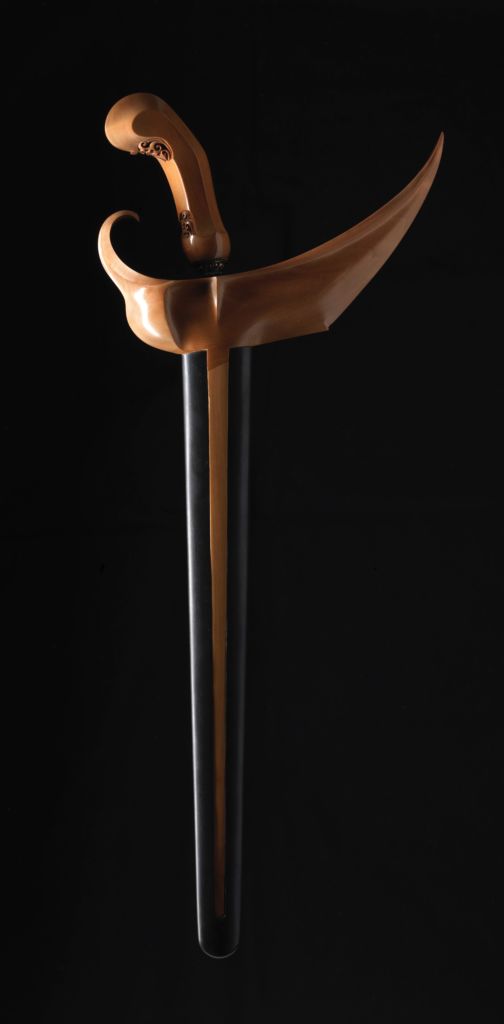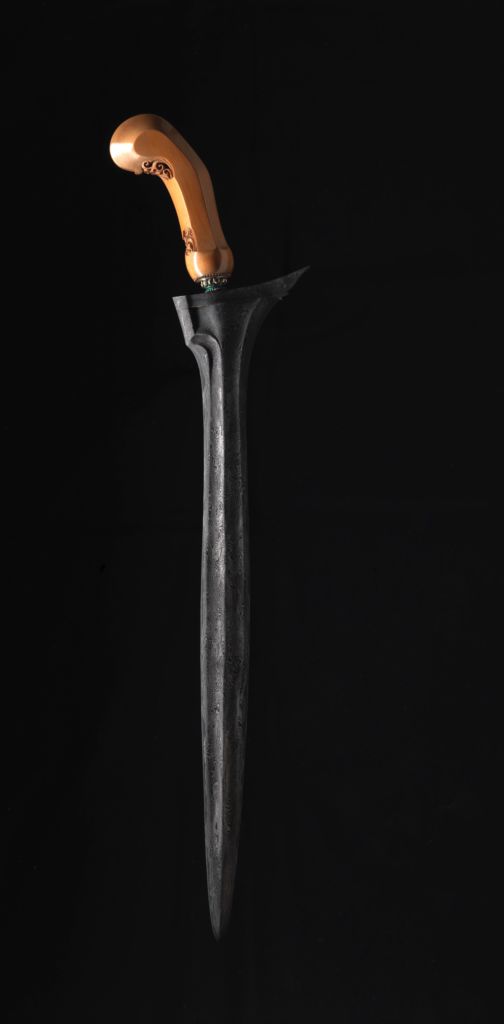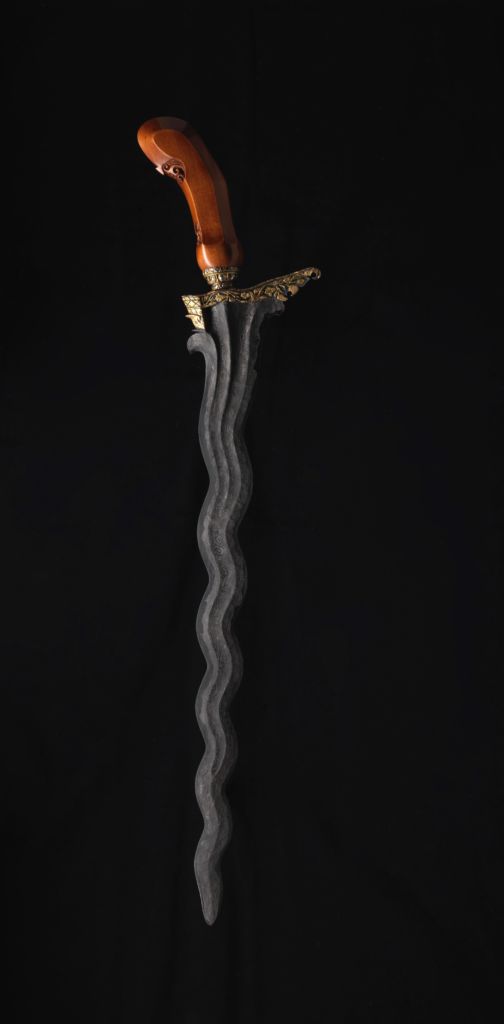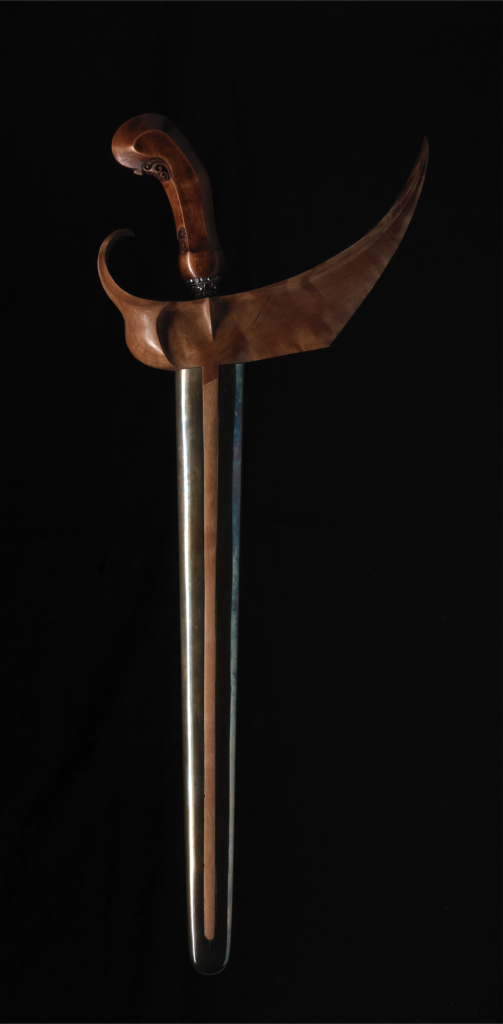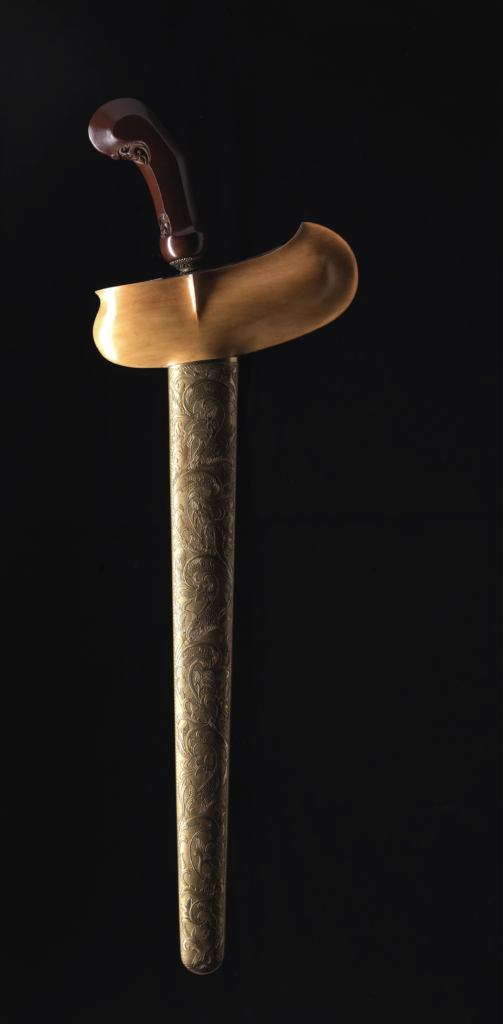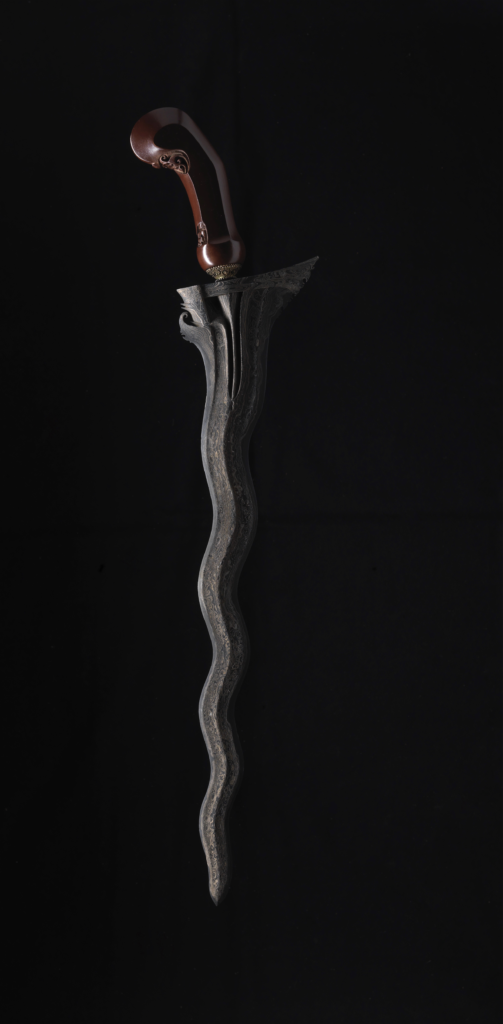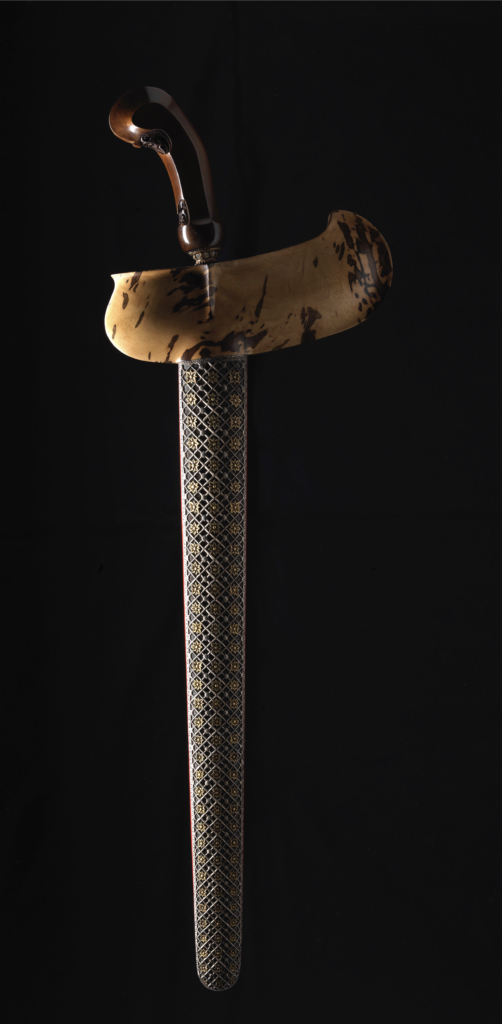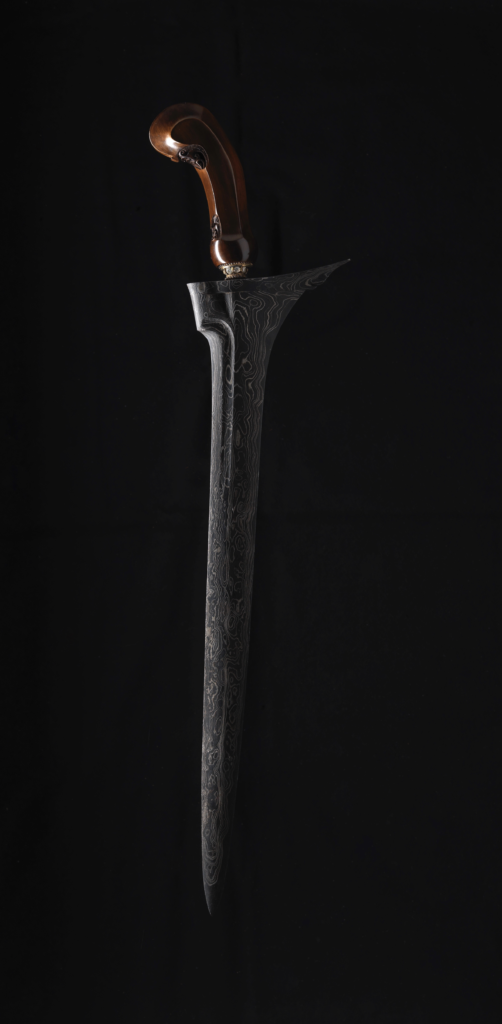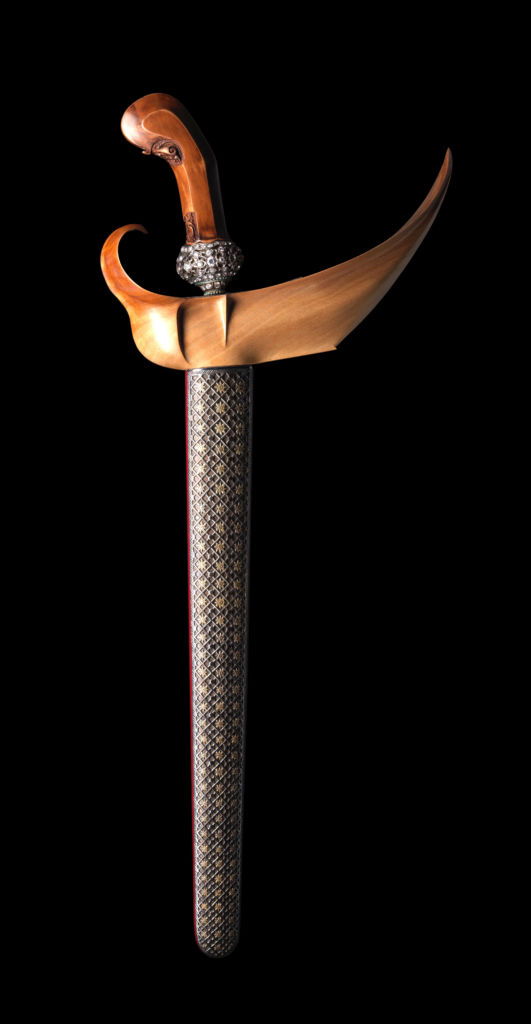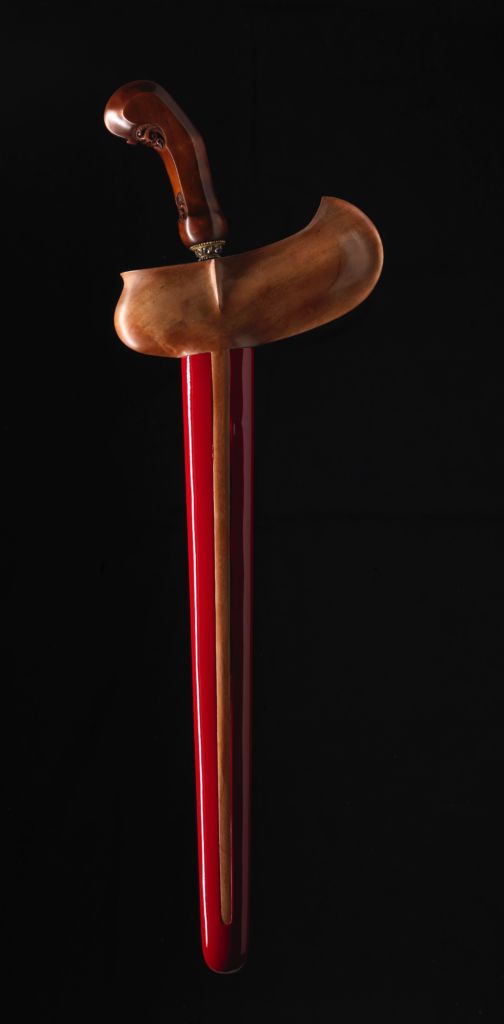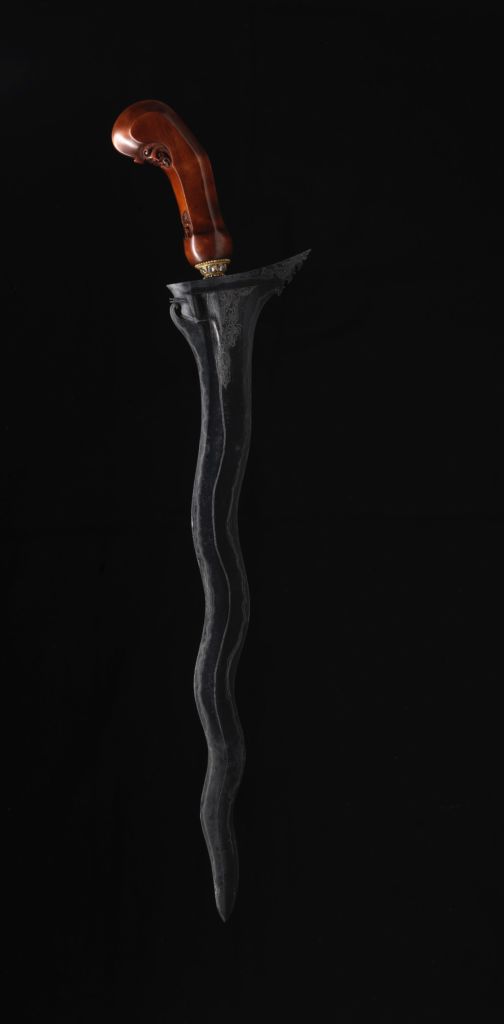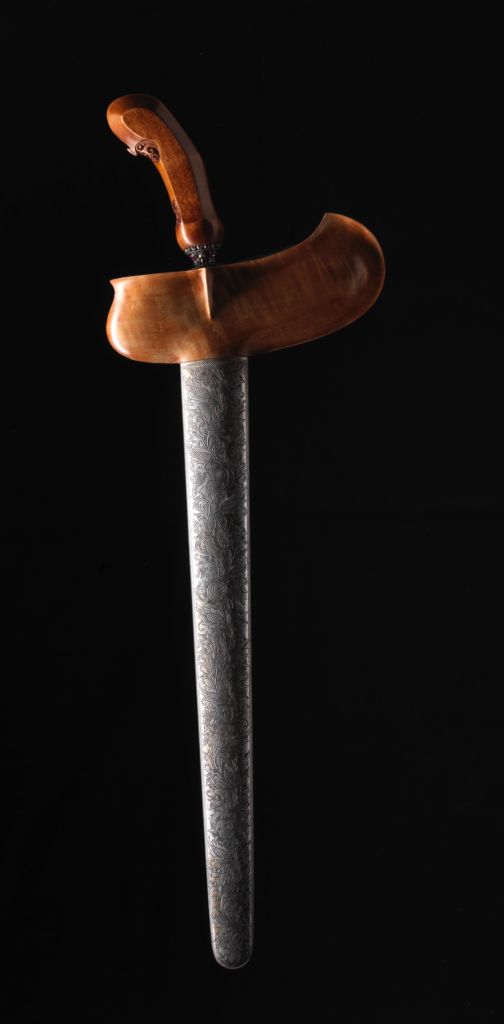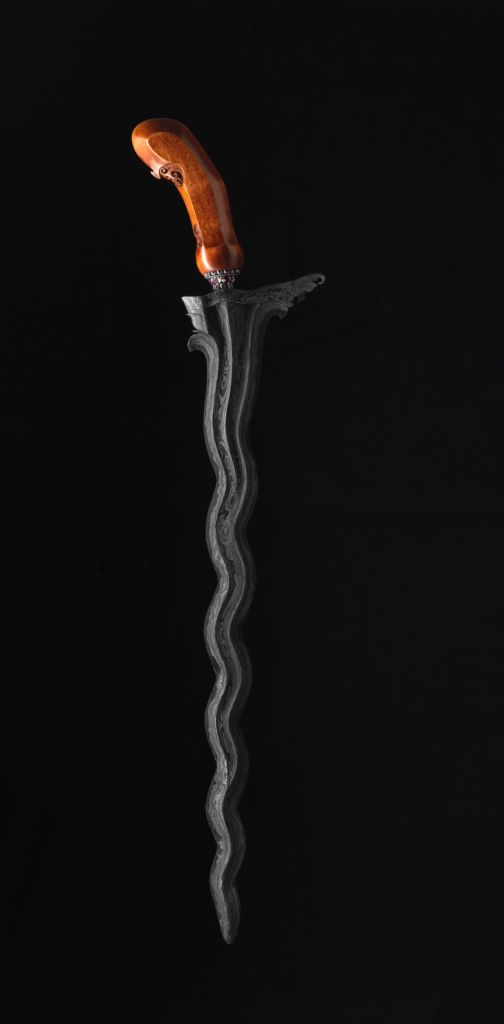D01
Era: Keris Surakarta, tangguh Kamardikan (keris made in Indonesian independence era) Forged at the end of the 70ies by empu Ki Josopangarso in Blitar
shape: dapur jalak dinding
Pamor: lar gangsir (untiran)
Deder / handle: tunggak semi, cendana (sandalwood), topeng Surakarta, yudawinatan
Wrangka / scabbard: ladrang Surakarta, shape: kadipaten. Sandalwood. Blackened iron pendok blewah.
The design of this keris is a collaboration by Dietrich Drescher and the late pangeran (then K.R.T.) Hardjonagoro.
This keris is one of the most important keris of the Kamardikan era (keris made after WW II and since the foundation of the Indonesian republic). It was the favourite keris of Drescher and the first one after the Great War Drescher considered as “close to perfect”, besides the older keris nem-neman, which he always took as “state of the art” in the best cases. It is in the classical nem-neman-style of Surakarta, displaying a remarkable harmony in proportions and pamor.
Drescher developed the blade shape after consulting pangeran Hardjonagoro (then K.R.T., Kanjeng Raden Tumenggung”, a honorary title for keraton members) for the central Javanese aesthetic criteria towards wangun, shape. After modelling a polah, a hardwood model, in Hardjonagoro’s domcile, about 55 hours were spent in forging by ki Jeno, ki Joso and Drescher himself for each person, and about 20 hours more in finishing work for two craftsmen.
The pamor consists of 4 moderately twisted rods of high-density nickel pamor rods, two on each side of the slorok, the hard steel core.
The Surakarta style ladrangan scabbard is of peerless sandalwood, as is the handle, which follows the shape yudhawinatan. The carving work, especially of the patra, is executed in a perfect manner and embodies the most restrained elegance. The scabbard has an iron pendok blewah, which is normally only allowed for members of the royal family. An exception was made for Drescher on the request of Hardjonagoro, out of respect for his efforts.
D02
Era: Keris Surakarta, tangguh Kamardikan (keris made in Indonesian independence era)
pamor: nginden
shape: dapur panji paniwen pogog, ganja wilut (undulating), luk 13
Deder / handle: yudhawinatan or maraseba, mendak: pola bejen
Wrangka / scabbard: ladrang kadipaten, pendok lung kandhet. Fire-gilt silver
A keris commissioned by D. Drescher and made by Haji Duraphik at the beginning of the third millennium, displaying a classical design. Such keris are already known since the 16th century and probably earlier. The pamor material is pamor Luwu, molten in clay furnace by Drescher in the Poso region of Sulawesi one year before this keris was made (2006). The strong and powerful shape has 13 luk (waves).
Panji is a terminus which mostly refers to the design of the upper greneng, which are strong and prominent. The ganja is adorned with gold (kinatah emas), in the design lung kamarogan (hibiscus or jasmine pattern). Lung melati means “forest of jasmine”, referring to a symbolic domain of spiritual and mental purity.
The scabbard is al classical ladrangan Surakarta in kadipaten-shape, made of cendana-(sandal-) wood. It has an open pendok of gilt silver. The somewhat slender handle in maraseba – shape is allegedly meant for younger people of high status, but this is unconfirmed in keraton circles.
D03
Era: Keris Surakarta, tangguh Kamardikan (keris made during Indonesian independence era)
Pamor: adeg wengkon
Shape: dapur jalak dinding
Deder / handle: tunggak semi, patra Surakarta
Shape: yudhawinatan, mendak in pola kendit
Wrangka / scabbard: ladrang kadipaten, pendok blewah in suasa, cendana wangi
This keris was commissioned and designed by Dietrich Drescher and forged by Haji Duraphik in the late 90ies. Duraphik was one of the best blacksmith of modern times and his work is highly appreciated today. Most of the keris designed by Toni Junus were also forged by him.
The pamor material is based on a Nickel steel alloy. The metal is folded (wasuhan) and has a smooth “oily” surface. The profile of the blade can be considered as perfect in its elegance, well supported by the pamor, which does not affect the shape. The shape of this keris is a variation of the well-known dapur basopati, but with the difference that the gandik is closed. It is surely one of the most dignified shapes of younger keris, found in some of the best keris nem-neman (eg. by the famous makers empu Ki Singawidjaya and Ki Joyosukadga of Pakubuwana IX and X era).
The scabbard shows a classical Surakarta ladrangan design with an open pendok of darkened suasa (silver-copper-alloy).
D04
Era: Keris Surakarta, tangguh Kamardikan (keris made in Indonesian independence era)
Shape: dapur sempana
Pamor: beras wutah
Deder / handle: tunggak semi, topeng Surakarta, shape pakubuwanan, mendak bejen
Wrangka / scabbard: Gayaman Surakarta of Javanese sandalwood (kayu cendana), pendok bunton of gilt copper in lung Eropa (“European style”).
This keris was made by empu Subandi in the early 80ies. It was designed and commissioned by Dietrich Drescher. It is a putran (copy) of a famous heirloom keris by Ki Joyosukadgo. Pangeran Hardjonagoro, the owner of the original keris, provided a polah (model) for the craftsmen.
The pamor material is nickel.
The scabbard is a typical moderate gayaman design of the Surakarta style (in this case: kagok banci) from fragrant sandalwood.
The closed pendok is specifically showing the widasari or kembang setaman-pattern referring to Hindu symbolism. The design is influenced by Europe due to the historic links of Surakarta with the Dutch colonial government.
D05
Era: Keris Surakarta, tangguh Kamardikan (keris made in Indonesian independence era)
Shape: dapur pulang geni
Pamor: beras wutah, pamor Prambanan
Deder / handle: yudhawinatan, topeng Surakarta.
Wrangka / scabbard: gayaman in the shape kagok bancih, wood: kayu timaha (Cassia laevigata) in pelet ngingrim grain, pendok bunton, nam-naman-pattern, pendok kemalo (backside in red lacquer)
This keris is very special because of the use of pamor Prambanan given by pangeran Hardjonagoro to Dietrich Drescher for this keris project. It is a putran of a pusaka ot tangguh Demak (16th century). It was forged by Johanes Yantono.
The scabbard is crafted to a high standard. The grain pattern of the timaha (Kleinhovia Hospita) wood is especially fine.
The red lacquered pendok (kemalo) has a checkered nem-neman-pattern with petals on its front side. It is made from partially gilt openwork silver with a background of darkened copper.
This keris can be considered as a good example for a high-ranked keris in Surakarta style.
D06
Era: Keris Surakarta, tangguh Kamardikan (keris made in Indonesian independence era)
Pamor: lawe satukel
Shape: dapur basopati
Deder / handle: tunggak semi in patra Surakarta, shape: yudhawinata, selut with jawa inten (impure Javanese diamonds). Mendak (stem-ring) in bejen-shape, set with diamonds.
Wrangka / scabbard: ladrang Surakarta, shape: kadipaten
Pendok: bunton, pattern nam-naman, pendok kemalo (red laquer)
This keris was made by Ki Suyanto during the 1980s. The design was provided by Dietrich Drescher. It shows the typical characteristics of a keris in wangun (shape) Surakarta, referring to nem-neman-keris of the era Pakubuwana IX and X, the golden era of younger keris. The pamor material is pure nickel.
The pamor of the straight blade is lawe satukel. Its shape is basopati, referring to the mythical arrow in Hinduistic mythology. The handle is held in the classical Surakarta shape, pakubuwanan or yudawinatan. The base is set in a silver ferrule, selut, studded with Javanese diamonds.
The scabbard is a ladrangan Surakarta, the “formal sheath”. It is covered by a closed (bunton) silver pendok with a geometrical flower pattern in gilded silver. The backside is covered with red lacquer (pendok kemalo), a detail which refers to the owner’s high status and protects the blade from losing its inherent power.
D07
Era: Keris Surakarta, tangguh Kamardikan (keris made during Indonesian independence era)
Dapur: carubuk
Pamor: dwi warna, (“two-tone”), adeg wengkon combined with pamor nggrajih or tirta teja.
Pamor material: Meteoritic iron from the Gibeon-meteorite
Deder / handle: tunggak semi, cendana (sandalwood), topeng Surakarta, yudawinatan, mendak in pola kendit
Wrangka / scabbard: gayaman Surakarta, with red laquer pendok (kemalo)
This keris in wangun Surakarta was made by empu Subandi Supodiningrat on a commission of Dietrich Drescher during the year 1997. The design was done by Dietrich Drescher. The blade is thick and sturdy and has a prominent tempering making it able to pierce a coin without any traces at the tip afterwards. The shape is a classical caburuk with 7 luk. With sogokan, this dapur would be balebang. The metal is black and oily. The shape is found in some very old keris.
The pamor consists of meteoric iron from the Gibeon meteorite, which Drescher bought in Germany with a certificate. It was delivered in blocks showing the Widmannstaedt’sche patterns, which cannot be artificially emulated.
The wrangka is a gayaman Surakarta of the type kagok bancih, one of the most common shapes. It is of kayu cendana (sandalwood) and has a red lacquered pendok.
D08
Era: Keris Surakarta, tangguh Kamardikan (keris made in Indonesian independence era)
Pamor: beras wutah
shape: dapur panji paniwen pogog, 13 luk
Deder / handle: tunggak semi in topeng Surakarta, style is a slender maraseba, mendak is a pola muncar set with stones
Wrangka / scabbard: gayaman Surakarta, silver pendok bunton with lung maraseba pattern
This keris was commissioned by Drescher in 2004 and is one of the last ones he realized. It shows very graceful lines. It was made by the late Haji Duraphi of Madura, one of the most prolific makers of modern times. The shape is inspired from the late Majapahit keris, a shape which was continued in the early Mataram II-era. Typical is the cross section with a sword-like central fuller. A straight version of this shape would be called panji anom. The terminus panji seems to refer to a special aesthetic feeling, implying manliness and male energy, controlled and hidden behind good manners.
This keris was made using real pamor Luwu from the lake Poso region in Sulawesi, molten by Drescher in a clay furnace in 2001.
The wrangka is a gayaman Surakarta, made from finely grained sandalwood. The closed pendok is made from thick silver and has a lung widasari pattern in European style.

